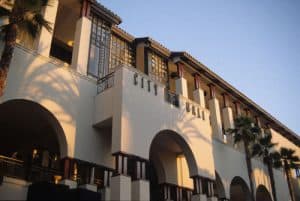 With only one item on the agenda, the City Council had a very clear mission on Monday, March 20, 2017. To enact a 45 day moratorium on the lower and upper Culver Crest to “address the urgent issue of hillside development in the Culver Crest neighborhood.”
With only one item on the agenda, the City Council had a very clear mission on Monday, March 20, 2017. To enact a 45 day moratorium on the lower and upper Culver Crest to “address the urgent issue of hillside development in the Culver Crest neighborhood.”
The issue of what might be built had drawn intense attention from the neighbors, and the history of slides on the terrain made it seem all the more urgent with another series of storms in the forecast. Dark clouds were literally gathering as the meeting was convened, with rain slated for the following morning.
Dating the “Temporary draft ordinance” from Feb. 27, 2017 , the city staff called for a 45 day moratorium. Community Development Director Sol Blumenfeld stated “Staff recommends the council vote for the moratorium, to preserve the public peace, health and safety.”
Of the 54 people who spoke to the issue of development in the Culver Crest neighborhood at the previous meeting in February, more than 20 came back to address the council again in support of the moratorium.
Nicholas Cregor addressed the geological findings that supported the safety of the plans Troy Jackson had the city approve of towards developing his property on Cranks Road. “If he’s wrong, someone could get killed. We are playing the game of ‘my geologist knows more than your geologist .’ These [proposed] buildings are in line with very real dangers known to the area. I totally support the moratorium. If Mr. Jackson thinks he can beat it all, he hasn’t been here through a landslide.”
Many speakers brought up the history of the hill sliding, noting that rainfall was the key factor, and that four major landslides over the last several decades seemed more powerful evidence that geology reports, however thorough.
Those who disagreed sought to characterize the objections as emotional rather than factual.
Daniel Mayeda spoke to the council, saying “It is what the Staff report outlines, and the orderly process that has brought us to this point – not ’emotional neighbors.’ Staff needs time to complete their studies, and this moratorium is completely appropriate. Last month, the hill behind Bernardo Road gave way. This is why studies should be done. Let’s engage in a sensible process to determine what should be built.”
Jennifer Marlis also addressed the dismissive label. “We have been characterized as emotional and angry. I am calm and pragmatic. [We need to] study all of the land under Culver Crest. The best predictor of if a hill will slide is it’s history, and the current [weight] seems to be far above what the current wall was built to support.”
Jennifer Hodur was one of those who lost property in the previous slide in 2005, and offered her observation, “We lost our house in the 2005 slide. The difference between living in a dream house and living in a nightmare [can be sudden] I don’t know the Jackson family, and I wish them no ill will, and I hope they never have to go through what we went through. Please take all appropriate action to prevent this from happening.”
When the property owner Troy Jackson took the podium, he was cool but confrontational. “Neighbors don’t get to decide what other neighbors can build on their own property.” He emphasized that this was private capital building on private property and had already had a green light from the city before it became an issue before the council.
“They hatched a plan to legally ensnare the project. There are cassons that will stabilize [the foundation] Five geologists have done reports on this project.” Jackson held that his right to build was being unfairly postponed.
Steve Gourley, former Mayor of Culver City and resident of the Culver Crest neighborhood, took to the podium with absolute confidence. “I am very proud that Town Hall democracy can take place here. There are lots of places in this county where it can’t happen, but we have it happening right here.”
As is often his winning tactic, Gourley had publicly available information that it seemed no one else had accessed, and put his voice to great use emphasizing salient facts with greater volume.
“Why do THREE structures on that hill have cassons and pilings on the main house? I ask you to look at the California Division of Mines and Geology Report on the slopes and hills of the Baldwin Hills. Our City Attorney has a copy of this report for anyone to read. This principle erosion, just south of Tellefson, is within TEN FEET of where [Jackson’s] property ends. This report was not done for the city or for any homeowners. It’s a geological report from the state. It’s OBJECTIVE information.”
With the public hearing over, the council took the discussion though the building code, the extent of the moratorium, the map in question, and what standards the city had to meet for public safety.
Council member Göran Eriksson noted that it really was about the angle of repose. “If you have 10,000 feet of property and it’s flat, you can build on that but if you have 10,000 feet of property and 80% of it is one slope, you can’t build on that.”
Blumenfeld agreed. “If soil won’t stay put, it’s called the angle of repose, it requires support, it needs to have different standards.”
The motion passed using the language as it was written, with five ayes. Further discussion would return to the council on April 11, 2017 when there was an expectation of more studies from the staff on what could and could not be built on the Culver Crest.
Meanwhile, it’s raining again.
Judith Martin-Straw


Be the first to comment